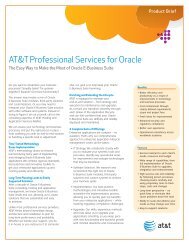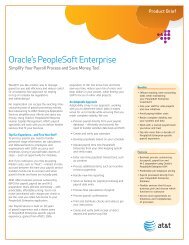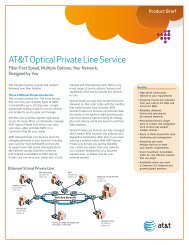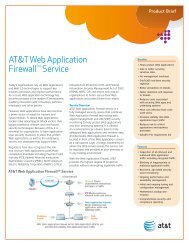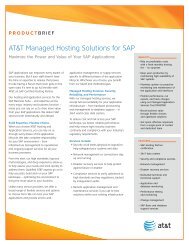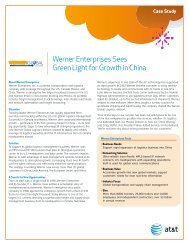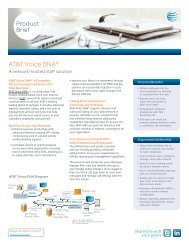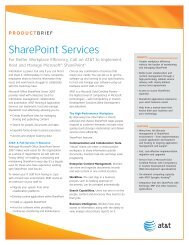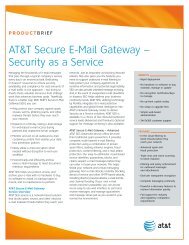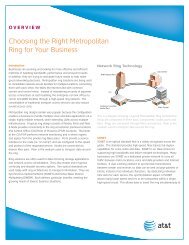An AccuWeather Cloudlet Answers a Hail of Data Requests
An AccuWeather Cloudlet Answers a Hail of Data Requests
An AccuWeather Cloudlet Answers a Hail of Data Requests
Create successful ePaper yourself
Turn your PDF publications into a flip-book with our unique Google optimized e-Paper software.
Case Study<br />
<strong>An</strong> <strong>AccuWeather</strong> <strong>Cloudlet</strong> <strong>An</strong>swers a<br />
<strong>Hail</strong> <strong>of</strong> <strong>Data</strong> <strong>Requests</strong><br />
About <strong>AccuWeather</strong>, Inc.<br />
<strong>AccuWeather</strong> is the World’s Weather Authority, leading the production<br />
<strong>of</strong> weather content and information. From its headquarters in State<br />
College, Pennsylvania, <strong>AccuWeather</strong> experts gather and analyze global<br />
weather data to provide accurate, localized weather forecasting and<br />
related information to customers worldwide. With a keen understanding<br />
<strong>of</strong> weather and its impact on peoples’ lives, founder Dr. Joel N. Myers<br />
developed his forecasting business into a global media company<br />
that serves government agencies, international media networks,<br />
corporations and individual Web and mobile device users. <strong>AccuWeather</strong><br />
products and services range from customized reports and proprietary<br />
weather graphics to 15-day forecasts and severe weather alerts.<br />
Situation<br />
In recent years the use <strong>of</strong> mobile devices to retrieve <strong>AccuWeather</strong><br />
widgets and applications has mushroomed. In just one year, weather<br />
inquiries from mobile users grew from 50 million to 650 million requests<br />
per day. But discrepancies in the way some mobile devices communicated<br />
their locations threatened to compromise <strong>AccuWeather</strong>’s application<br />
performance. These global positioning system (GPS) locators pinpointed<br />
the user’s position with extreme precision. <strong>Requests</strong> from some <strong>of</strong><br />
these devices were specific down to a square nanometer, degrading<br />
<strong>AccuWeather</strong>’s network edge efficiency, and forcing redundant<br />
requests for weather updates back to headquarters. The result was<br />
inefficient use <strong>of</strong> a global network-based cache and ultimately excess<br />
work for the company’s data servers. <strong>AccuWeather</strong> needed a way to<br />
meet the growing demands for real-time information without growing<br />
its infrastructure investment.<br />
Solution<br />
<strong>AccuWeather</strong> implemented AT&T Content Acceleration <strong>Cloudlet</strong> module<br />
that shortens the GPS parameters to a more manageable level. The<br />
majority <strong>of</strong> requests can now be delivered from a network-based<br />
cache without having to travel back to headquarters for the latest<br />
forecast. Users get the information that they need more quickly<br />
without taxing the capacity <strong>of</strong> the origin servers or requiring an<br />
additional hardware investment.<br />
Local Weather Forecasts on the Global Stage<br />
Established in 1962, <strong>AccuWeather</strong> has evolved into the world’s leading<br />
provider <strong>of</strong> weather information. The company has pioneered precision<br />
weather forecasting and dynamic content distribution, creating a<br />
wide-reaching information network that includes its high-pr<strong>of</strong>ile<br />
media presence, mobile device applications and the comprehensive<br />
website <strong>AccuWeather</strong>.com. From local weather forecasting and severe<br />
weather warnings to UV index and weather-related health reports,<br />
<strong>AccuWeather</strong> provides people with critical information to help them<br />
navigate their daily lives.<br />
<strong>AccuWeather</strong> employs 113 meteorologists at its central Pennsylvania<br />
headquarters. They and more than 200 other employees gather,<br />
analyze, and distribute weather data worldwide, providing local weather<br />
forecasting for every corner <strong>of</strong> the globe. Reporting in 36 different<br />
languages, <strong>AccuWeather</strong> serves the U.S. and more than two million<br />
locations outside the country. Its customers include government<br />
agencies, educational institutions, Fortune 500 corporations, news<br />
networks and individual subscribers.<br />
<strong>AccuWeather</strong> developed out <strong>of</strong> an understanding that access to<br />
accurate information can help guide important, even life-saving,<br />
responses. In creating and distributing weather information, it has<br />
become more than simply a forecasting business. “At the end <strong>of</strong> the<br />
day, <strong>AccuWeather</strong> is a media company and weather is our content,”<br />
said CIO Steven R. Smith.<br />
<strong>AccuWeather</strong>, Inc. Facts<br />
• Business Needs<br />
Serve a fast-growing number <strong>of</strong> mobile device users<br />
without the need for major infrastructure investments<br />
• Networking Solution<br />
AT&T Content Acceleration <strong>Cloudlet</strong> module feature enables<br />
more efficient handling <strong>of</strong> weather-related requests<br />
• Business Value<br />
Quicker response times and improved user experience with<br />
existing web infrastructure<br />
• Industry Focus<br />
Full-service weather media company<br />
• Size<br />
Global weather coverage across the U.S. and to over two<br />
million locations worldwide
Case Study - <strong>AccuWeather</strong>, Inc._______________________________________________________________________________________________________________ 2<br />
The company’s growth has been marked by one innovation after<br />
another. Its advancements include the first seven-day forecast for<br />
television, weather graphics and even new terminology to make the<br />
potential <strong>of</strong> severe storm impact understandable. Keeping ahead<br />
<strong>of</strong> the trends to ensure the timely accessibility <strong>of</strong> its information,<br />
<strong>AccuWeather</strong> experts identify global patterns – not solely in weather,<br />
but in technology and communications. “Our goal is to make sure<br />
that the content we create here is available on any platform that’s out<br />
there,” Smith explained.<br />
Challenges <strong>of</strong> a Mobile Market<br />
With the evolution <strong>of</strong> mobile devices and smartphone technology,<br />
<strong>AccuWeather</strong> is experiencing growth in both volume <strong>of</strong> users and<br />
variety <strong>of</strong> information requested. “Mobile has grown leaps and bounds,”<br />
said Smith. Just in the past year, requests to <strong>AccuWeather</strong>’s mobile<br />
applications have increased from 50 million to 650 million per day.<br />
Such growth has brought both opportunities and challenges. One such<br />
challenge has been the functionality <strong>of</strong> the devices themselves.<br />
Smartphones use internal GPS locators to provide each consumer<br />
with highly localized, almost personalized, information. “The GPS<br />
coordinates drive everything from language to location so translation<br />
needs to be correct,” said Smith. However, the data parameters used<br />
by some mobile device locators were too precise since they were<br />
programmed to request pinpoint weather information for GPS locations<br />
defined by fifteen decimal points <strong>of</strong> latitude and longitude. Such precision<br />
might be needed for locating the closest espresso stand or making the<br />
correct right turn. But the hyper-detail <strong>of</strong> these requests multiplied<br />
their number so that even moving a device from one side <strong>of</strong> a desk to<br />
the other could result in a request for refreshed data. “These requests<br />
were coming back to State College and then the data was brought<br />
back out. The traffic explosion was dramatic,” Smith said.<br />
The excess network travel and computation slowed response times<br />
and could compromise end-user experience. “Our customers rely on the<br />
information being localized and accurate, and they want these products<br />
quickly,” said Jon Porter, engineer and member <strong>of</strong> the <strong>AccuWeather</strong><br />
enterprise architecture team. “Every time you come back to origin, you<br />
are increasing the round trip time for the users,” Smith added. “We<br />
were watching our servers ramp up in terms <strong>of</strong> utilization and usage<br />
on a daily basis.” The system was in danger <strong>of</strong> being overloaded.<br />
Trimming Travel Time<br />
“We decided on something that makes sense for our business –<br />
deliver the highly localized information that are customers need<br />
while not flooding our entire infrastructure,” said Porter. <strong>AccuWeather</strong><br />
implemented an AT&T Content Acceleration <strong>Cloudlet</strong> module that<br />
changes the parameters defined by the mobile device to match the<br />
<strong>AccuWeather</strong> data format. In this case, the <strong>Cloudlet</strong> truncates the<br />
number <strong>of</strong> decimal points specified for latitude and longitude from<br />
fifteen points to two.<br />
“It takes the data coming from the device, reduces it to a level to get<br />
the accuracy and localized information that we need, and then<br />
attempts to extract that information out at the network edge,” Porter<br />
explained. This prevents the requests from having to travel to the<br />
origin server. Like a business model <strong>of</strong> field <strong>of</strong>fices which handles<br />
transactions at a distance from company headquarters, the <strong>Cloudlet</strong><br />
reduces traffic to and from the main <strong>of</strong>fice.<br />
“Our goal is to make sure that the content we create<br />
here is available on any platform that’s out there.”<br />
– Steven R. Smith, CIO, <strong>AccuWeather</strong>, Inc.<br />
With the AT&T Content Acceleration <strong>Cloudlet</strong> module, transaction<br />
time is improved, and <strong>AccuWeather</strong> is saved from having to buy and<br />
maintain more servers. Origin server usage has decreased by about<br />
75 percent. “Before, the system was utilizing resources at very high<br />
levels for very computational processes,” said Smith.<br />
Forecasting Future Growth<br />
The <strong>Cloudlet</strong> module can be readily adapted to resolve similar issues<br />
in the future. It enables changes to any kind <strong>of</strong> data request, and is<br />
adaptable to the multitude <strong>of</strong> emerging devices and formats. “The service<br />
allows us to interrogate any incoming URL and change it however we<br />
see fit to make it match the best possible result,” Smith explained.<br />
Once an application is written into a device, it’s difficult to quickly<br />
rewrite that code. AT&T Content Acceleration <strong>Cloudlet</strong> module<br />
gives <strong>AccuWeather</strong> the flexibility to respond quickly and update its<br />
interactions with these mobile devices even after they’re out on the<br />
market. “The fact that we will have a way to manipulate after the fact<br />
is a great thing,” said Smith. “We are not just a data provider in that<br />
case; we really are a solutions provider too.”<br />
The mobile market is constantly evolving, with new devices being<br />
developed and rolled out daily. “As the next generation comes out,<br />
we are making sure that we have even more compelling content and<br />
features that play to new technology enhancements so we can deliver<br />
weather information to people that need it in new ways everyday,”<br />
said Porter. “Having this kind <strong>of</strong> technology in our set <strong>of</strong> capabilities is<br />
going to be very helpful.”<br />
Needs Are Met<br />
Implementation <strong>of</strong> the AT&T Content Acceleration <strong>Cloudlet</strong> module<br />
was a collaborative process. “We had a strong relationship AT&T<br />
already,” explained <strong>An</strong>thony Hatch, Senior web server administrator.<br />
“They have a good understanding <strong>of</strong> how our data is used and what<br />
our needs are.” All in all, the implementation took about half <strong>of</strong> a day’s<br />
worth <strong>of</strong> work, from start to finish,” added Smith.<br />
<strong>An</strong>d in the future? The flexibility and fast, straightforward<br />
implementation <strong>of</strong> the AT&T Content Acceleration solution make this<br />
an extremely useful tool. “I have a feeling we will use this service in<br />
different ways that we haven’t even thought <strong>of</strong> yet,” Smith said.<br />
For more information contact your AT&T Representative or visit us at www.att.com/business.<br />
04/07/11 AB-2106<br />
© 2011 AT&T Intellectual Property. All rights reserved. AT&T, AT&T logo and all other AT&T marks contained herein are trademarks<br />
<strong>of</strong> AT&T Intellectual Property and/or AT&T affiliated companies. All other trademarks are the property <strong>of</strong> their owners. Actual results<br />
and your experience may vary from those described in this case study. Information and <strong>of</strong>fers subject to change. Please contact your<br />
sales representative for additional information.



